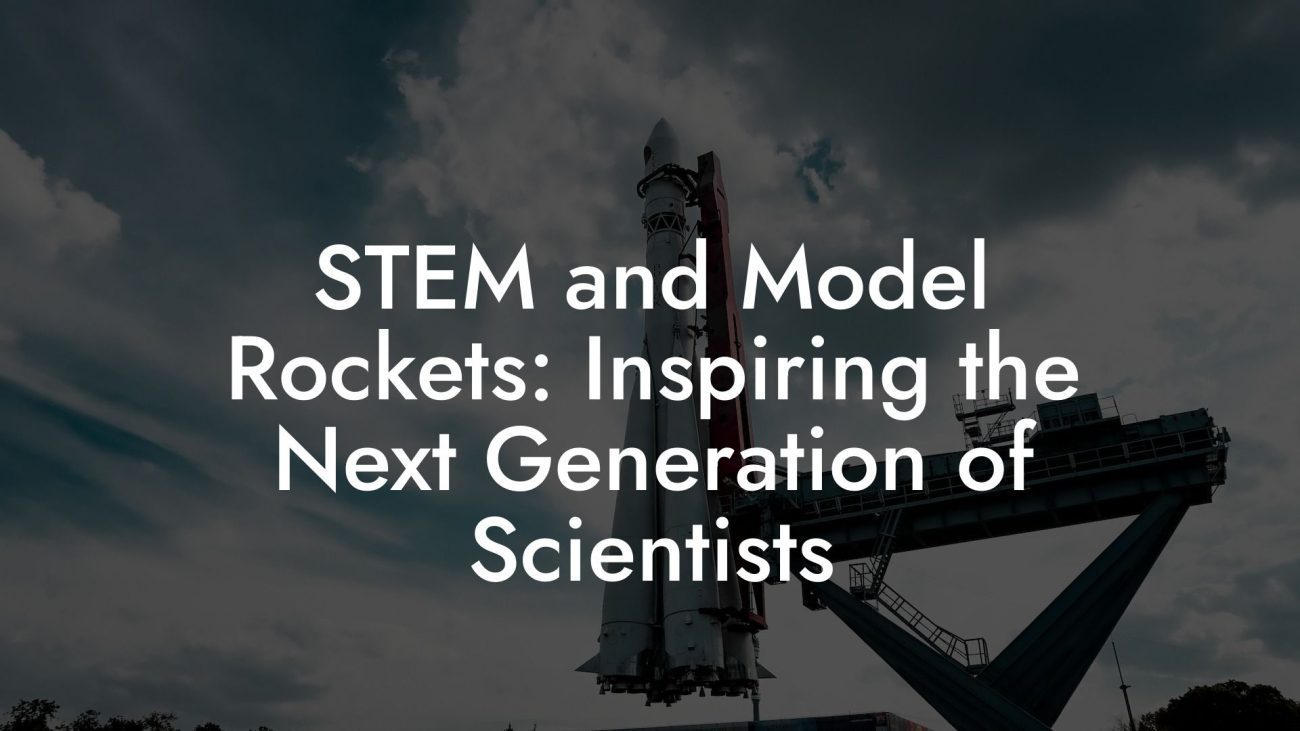Model rockets are no longer just backyard experiments – they have evolved into sophisticated tools that inspire innovation, fuel scientific curiosity, and even shape the future of space exploration. In "How Model Rockets Are Shaping the Future of Space Exploration," we dive deep into the science, technology, and community behind these high-flying miniatures, and explore how they serve as a stepping stone for the next generation of aerospace pioneers.
Quick Links to Useful Sections
- Introduction: From Backyard Hobby to Aerospace Catalyst
- The Science Behind Model Rocketry and Its Space Exploration Applications
- Newton’s Laws and the Basics of Rocket Flight
- Aerodynamics and Structural Engineering
- Chemistry of Propellants and Combustion
- Digital Innovations and Simulation: Shaping the Future of Design
- CAD and Virtual Prototyping
- Real-Time Telemetry and Data Analytics
- Engineering Innovations: Materials, Manufacturing, and Modularity
- Advanced Materials and Manufacturing Techniques
- Modularity and Upgradability
- Inspiring the Next Generation: Educational Outreach and STEM Integration
- STEM Education and Community Engagement
- Case Studies: Model Rockets Inspiring Space Exploration
- Case Study: From Backyard Hobby to Space Startup
- Case Study: Educational Programs Leading to Careers in Aerospace
- Case Study: Collaborative Innovations at Competitions
- The Future of Data-Driven Rocketry and Space Exploration
- Model Rocketry FAQs: The Science Behind the Flight
- Your Next Launch: Harness the Power of Data, Innovation, and Education
Introduction: From Backyard Hobby to Aerospace Catalyst
For decades, model rocketry has been a beloved hobby for enthusiasts of all ages. What began as simple kits assembled in garages has grown into a dynamic, interdisciplinary field that combines art, science, and engineering. Today, model rockets not only provide a platform for hands-on learning and innovation but also serve as a microcosm of the challenges and triumphs of space exploration. Through iterative design, digital simulation, and community-driven experimentation, these small-scale rockets are influencing larger aerospace endeavors and igniting the passion for exploration in future scientists and engineers.
In this comprehensive guide, we will explore how model rocketry is shaping the future of space exploration. We will examine the scientific principles that underpin rocket flight, the cutting-edge technologies used in modern rocketry, and the ways in which hobbyists and professionals alike are using these miniature vehicles as a springboard for groundbreaking ideas. From educational outreach to commercial innovation, model rockets are proving that even the smallest projects can have a monumental impact on our quest to explore the cosmos.
The Science Behind Model Rocketry and Its Space Exploration Applications
At its core, rocketry is a blend of physics, chemistry, and engineering – disciplines that are fundamental to space exploration. Understanding these scientific principles not only enhances the performance of model rockets but also provides critical insights for the development of larger spacecraft.
Newton’s Laws and the Basics of Rocket Flight
The principles of motion discovered by Sir Isaac Newton remain the cornerstone of rocketry. Newton’s three laws explain how a rocket overcomes gravity and accelerates into space. The law of inertia ensures that a rocket at rest will remain so until a force is applied. The second law, expressed as F=ma, shows that a rocket’s acceleration depends on the thrust generated by its engine relative to its mass. Finally, Newton’s third law reminds us that for every action, there is an equal and opposite reaction – a concept that underpins the engine’s ability to propel a rocket by expelling exhaust gases at high speed.
Looking For The Best Model Rocket Kits? You'll Love These:
These fundamental concepts are not only critical in designing model rockets but also provide the theoretical framework for launching massive spacecraft. Engineers working on commercial and scientific missions apply these same principles to design engines that deliver the required thrust to break free from Earth’s gravitational pull.
Aerodynamics and Structural Engineering
Aerodynamic efficiency is crucial to both model rockets and full-scale spacecraft. Minimizing drag, optimizing fin design, and ensuring structural integrity are challenges that model rocketeers tackle on a small scale every time they build and launch their rockets. Techniques such as wind tunnel testing and computational fluid dynamics (CFD) simulations used in the design of model rockets mirror the methods employed by aerospace engineers to improve the aerodynamics of rockets and space vehicles.
In both arenas, a smooth, aerodynamic profile can mean the difference between a stable flight and a catastrophic failure. By experimenting with different shapes, materials, and surface finishes, model rocketeers contribute to a broader understanding of how to optimize designs for high-speed, high-altitude flights.
Chemistry of Propellants and Combustion
The combustion process is the heart of any rocket engine. In model rocketry, chemical reactions between fuel and oxidizer produce high-temperature, high-pressure gases that are expelled to create thrust. The delicate balance of chemical components – from the oxidizers that provide oxygen to the fuels that burn to release energy – is a subject of ongoing research and experimentation.
Advances in propellant chemistry in the world of model rockets often translate into innovations for larger-scale applications. The development of eco-friendly propellants and more efficient combustion processes in model rocketry paves the way for similar breakthroughs in the aerospace industry, where reducing toxic emissions and improving efficiency are of paramount importance.
Digital Innovations and Simulation: Shaping the Future of Design
Modern model rocketry leverages digital tools to push the boundaries of design and performance. Computer-aided design (CAD) software, simulation platforms, and digital telemetry systems have revolutionized how enthusiasts prototype, test, and refine their rockets.
CAD and Virtual Prototyping
Programs such as Fusion 360, SolidWorks, and Tinkercad enable rocketeers to create intricate 3D models of their rockets with precise measurements and tolerances. These virtual models can be tested using simulation software to predict aerodynamic behavior, structural stresses, and engine performance before any physical construction begins.
This process of virtual prototyping not only saves time and resources but also allows for rapid iteration. Engineers and hobbyists alike use these tools to fine-tune every aspect of their designs, leading to more reliable and efficient rockets. The same principles are applied in the aerospace industry, where simulations help optimize spacecraft design, reducing risks and improving safety.
Real-Time Telemetry and Data Analytics
With the integration of digital sensors and data loggers, model rockets now capture real-time flight data. This telemetry data, which includes altitude, velocity, acceleration, and engine performance, is critical for post-launch analysis and continuous improvement.
By analyzing flight data, rocketeers can identify performance gaps and adjust their designs accordingly. This data-driven approach is mirrored in modern space missions, where engineers rely on detailed analytics to monitor spacecraft health, optimize flight trajectories, and troubleshoot issues in real time.
Digital innovations not only enhance the design process but also foster a culture of continuous learning and optimization – a trend that is shaping the future of both model rocketry and space exploration.
Engineering Innovations: Materials, Manufacturing, and Modularity
As technology evolves, so does the engineering behind model rockets. Innovations in materials science and manufacturing techniques are enabling rocketeers to build lighter, stronger, and more efficient rockets.
Advanced Materials and Manufacturing Techniques
Modern rocketeers are embracing materials such as carbon fiber, fiberglass, and high-strength polymers to construct rocket bodies and fins that are both lightweight and durable. These materials, which are also used in commercial aerospace, allow for higher performance and better resistance to the stresses of launch and recovery.
3D printing and CNC machining have also become popular among enthusiasts, providing the ability to create custom parts with intricate geometries that were once impossible to manufacture using traditional methods. This democratization of advanced manufacturing not only boosts innovation in model rocketry but also serves as a training ground for future engineers.
Modularity and Upgradability
One of the emerging trends in both model rocketry and commercial spaceflight is modularity. Designing rockets with interchangeable components allows for easy upgrades, repairs, and customization. Modular designs enable rocketeers to experiment with different configurations, engines, and recovery systems, fostering a culture of continuous improvement.
This approach mirrors the modular strategies used in modern spacecraft design, where components can be replaced or upgraded without the need for a complete rebuild. Modularity in model rocketry not only reduces costs but also inspires innovative thinking, as enthusiasts are free to mix and match designs to achieve optimal performance.
Inspiring the Next Generation: Educational Outreach and STEM Integration
Model rocketry plays a crucial role in inspiring future scientists and engineers. Through hands-on projects, competitions, and collaborative learning experiences, young enthusiasts gain practical insights into physics, chemistry, and engineering.
STEM Education and Community Engagement
Many schools and community organizations use model rockets as an educational tool to teach fundamental STEM concepts. Workshops and competitions organized by local rocketry clubs provide an interactive platform for students to experiment, fail, learn, and succeed. These experiences not only build technical skills but also foster creativity, critical thinking, and a lifelong passion for science and technology.
As the aerospace industry continues to grow, the skills learned through model rocketry serve as a stepping stone for future careers in engineering, physics, and space exploration. By nurturing young talent, the rocketry community is helping to ensure a bright future for space exploration.
Case Studies: Model Rockets Inspiring Space Exploration
Real-world examples highlight how model rocketry has influenced major advancements in aerospace:
Case Study: From Backyard Hobby to Space Startup
One inspiring story is that of a former model rocketeer who, after years of experimenting with rockets in his backyard, founded a startup focused on small satellite launch vehicles. The hands-on experience with design, testing, and flight analysis provided a solid foundation for developing commercial rockets that now serve universities and small businesses.
Case Study: Educational Programs Leading to Careers in Aerospace
Many engineers and scientists in the aerospace industry credit their early exposure to model rocketry as the spark that ignited their passion for space exploration. Educational programs that incorporate rocketry projects have led to successful careers, driving innovation and research in space technology.
Case Study: Collaborative Innovations at Competitions
International competitions have also played a pivotal role in advancing rocketry technology. Teams from around the world come together to share ideas, push the boundaries of design, and create rockets that achieve unprecedented altitudes. These competitions not only foster healthy competition but also serve as a breeding ground for collaborative innovations that influence both amateur and professional aerospace projects.
The Future of Data-Driven Rocketry and Space Exploration
As we look to the future, the integration of advanced analytics, AI, and machine learning in model rocketry is set to revolutionize the hobby further. Imagine rockets that can adjust their flight parameters in real time based on predictive algorithms, or recovery systems that automatically adapt to changing atmospheric conditions. These advancements will not only enhance the performance of model rockets but will also provide critical insights that shape the design of future space vehicles.
The trend toward data-driven rocketry is a microcosm of the broader evolution in aerospace, where precision, efficiency, and adaptability are paramount. By embracing these digital innovations, today's rocketeers are laying the groundwork for tomorrow’s breakthroughs in space exploration.
Model Rocketry FAQs: The Science Behind the Flight
Here are some frequently asked questions to deepen your understanding of the scientific principles behind model rocketry:
1. How do Newton’s laws apply to rocket flight?
Newton’s laws of motion explain how rockets overcome inertia and gravity through the generation of thrust, with every action (expelling exhaust gases) resulting in an equal and opposite reaction (the rocket’s ascent).
2. What is the role of aerodynamics in model rocketry?
Aerodynamics determines how air flows around your rocket, affecting drag, stability, and overall flight performance. A streamlined design minimizes drag and maximizes altitude.
3. How does the combustion process generate thrust?
The combustion of rocket propellant produces high-pressure, high-temperature gases that are expelled through the nozzle, creating a reactive force that propels the rocket upward.
4. What materials are commonly used in model rocket construction?
Materials like balsa wood, fiberglass, carbon fiber, and reinforced plastics are popular due to their favorable strength-to-weight ratios and durability.
5. How do digital tools enhance rocket design and performance?
Digital tools such as CAD software, CFD simulations, and telemetry systems allow rocketeers to design precise models, predict aerodynamic behavior, and analyze flight data for continuous improvements.
6. Why is modular design important in rocketry?
Modular design allows for easy upgrades, repairs, and customization, enabling rocketeers to refine their rockets over time and adapt to new technologies.
7. How can iterative testing improve rocket performance?
Iterative testing provides valuable feedback on flight performance, allowing you to make incremental improvements to aerodynamics, engine alignment, and recovery systems.
8. What role do competitions play in advancing rocketry technology?
Competitions encourage innovation and collaboration, providing a platform for testing new designs, sharing ideas, and driving continuous improvements in performance.
9. How does telemetry contribute to data-driven rocketry?
Telemetry systems capture real-time flight data, enabling precise analysis of rocket performance and facilitating informed design adjustments for future launches.
10. What future technologies could further revolutionize model rocketry?
Emerging technologies such as AI-driven control systems, smart materials, and augmented reality for design and training are poised to transform rocketry, making launches safer, more efficient, and more innovative.
Your Next Launch: Harness the Power of Data, Innovation, and Education
As we explore the frontiers of space exploration through model rocketry, every launch becomes a testament to human ingenuity and the relentless pursuit of knowledge. By combining scientific principles with digital innovations, cutting-edge materials, and community collaboration, model rocketry continues to inspire and shape the future of aerospace.
Whether you’re a hobbyist, student, or aspiring engineer, the journey of data-driven rocketry offers endless opportunities for learning, innovation, and achievement. Embrace the science, leverage the technology, and let your passion for rocketry propel you into a future where every flight is a stepping stone toward the stars.
Looking For The Best Model Rocket Kits? You'll Love These:
Useful Interruption: Dive deeper into the world of Model Rockets with our most popular sections. If there is anything you think is missing or anything you would love for us to write about, just give us a shout.
- Getting Started & Basics With Model Rockets
- Model Rocket Design, Build & Customization
- Model Rocket Propulsion & Engine Technology
- Model Rocket Launch Techniques & Recovery
- Model Rocket Advanced Rocketry & Innovations
- Model Rocket DIY and Customization
- Model Rocket Equipment Reviews & Digital Tools
- Community, Competitions & Education
- Model Rocket Troubleshooting & FAQs
- Model Rocket Bonus/Seasonal & Niche Topics
A group of model rocket enthusiasts gathered at a field for their weekly launch event. Among them was Dave, a seasoned builder known for pushing the limits of hobby rocketry. This time, he had outdone himself.
“Ladies and gentlemen,” Dave announced, dramatically pulling a cloth off his latest creation, “I present to you: The Kraken!”
The crowd gasped. This wasn’t just a model rocket, it was a monster. The thing stood 8 feet tall, had six clustered engines, and was covered in enough duct tape to qualify as a classified aerospace project.
“Dave,” muttered Steve, the cautious safety officer, “Have you, uh… done the math on this?”
“Math?” Dave scoffed. “I built it in my garage at 3 a.m. with parts from eBay. This is an art piece, Steve.”
The countdown began.
5…
4…
3…
2…
1…
The engines ignited with a BOOM, and The Kraken shot up… kind of. It immediately did a violent barrel roll, narrowly missing the spectators before skyrocketing at an angle that could only be described as “legally questionable.”
The crowd collectively ducked as The Kraken flew straight over the adjacent cornfield, where Old Man Jenkins, the grumpiest farmer in town, was minding his business.
KABOOM!
The rocket disappeared behind the barn. A moment later, a flaming piece of Estes igniter wire landed at Steve’s feet. The silence was deafening.
And then, an unmistakable sound echoed across the field.
Jenkins’ shotgun being cocked.
“DAVE!!!” Steve shouted. “RUN.”
And that was the day Dave invented the first-ever biologically powered rocket booster: pure adrenaline.
To this day, nobody knows where The Kraken landed, but legend has it, it still haunts the skies, terrifying unsuspecting drones and low-flying birds.










